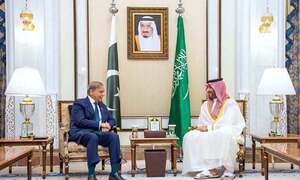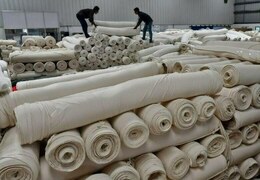When the US drones obliterated a car carrying Taliban leader Mullah Akhtar Mansour last month, it was the kind of targeted killing that unmanned aircraft are best known for. But 15 years after a drone first fired missiles in combat, the US military's drone programme has expanded far beyond specific strikes to become an everyday part of the war machine. Now, from control booths in the United States and bases around the Middle East, Afghanistan and parts of Africa, drone crews are flying surveillance missions and providing close air support for troops on the ground.
"In the wars we fight, this is the future," said drone pilot Lieutenant Shaw, as he stood in a hangar at the Air Force's drone base in the southern Afghan city of Kandahar. Crews spoke to Reuters on condition that only their first names and rank be used to identify them. The increased use of Unmanned Aerial Vehicles (UAVs) in a wide range of battle applications comes as the United States looks to reduce the number of soldiers fighting abroad.
The US military declined to provide statistics breaking down drone activity into types of missions, but dozens of interviews with people working in the secretive programmes show UAVs have become an integral tool on the battlefield. That is likely to raise further objections from critics who say drones often miss their intended targets, can only partly relay what is happening on the ground and encourage warfare with impunity waged by people at computer screens far from danger. In Afghanistan, the United States has around 9,800 troops left and plans to cut the level to 5,500 by early 2017.
At its peak a few years ago, the US military had around 100,000 soldiers there, yet the dramatic decrease does not mean the conflict is winding down. In fact, the Taliban insurgency is as potent now as at any time since 2001. As part of its expanding programme, the Air Force aims to double the number of drone squadrons over the next five years. Even some proponents, like retired Lieutenant Colonel T. Mark McCurley, a former Air Force drone pilot, say over reliance on remote killing and electronic intelligence has hurt efforts on the ground.
"Too often, remotely piloted aircraft are being used as a tool to wantonly kill individuals, rather than as one of many tools to capture and shut down whole terrorist networks," he said. Central to the shift towards remote operations is Afghanistan, where weak local forces, a dwindling troop presence and rugged terrain have made it something of a testing ground. Drones there log up to eight times as many flight hours as the few remaining manned fighter aircraft. They also release more weapons than conventional aircraft, Reuters reported in April.
For the first time, the top Air Force general in the country was trained as a drone pilot before he deployed, a move he said reflected the importance of unmanned aircraft in the broader military mission. "Our airmen are flying persistent intelligence, surveillance, reconnaissance, and strike missions all across Afghanistan," Major General Jeff Taliaferro told Reuters in Kabul, referring to the drone programme.
"They're performing everything from counterterrorism to base defence, and really it's a capability a lot of our missions have come to rely on." The latest generation of drones carries more and bigger weapons and an expanding payload of hi-tech sensors designed to handle a wider range of missions for the conventional military. The number of hours flown by the Air Force's newest attack drone, the MQ-9 Reaper, more than doubled globally between 2010 and 2015, to nearly as many hours as F-16 fighter jets, according to statistics from the Air Force Safety Center.
In a plan announced late last year, the Air Force proposed roughly $3 billion in funding to expand its attack drone force further, adding 75 of the latest Reaper aircraft. It already fields at least 93 Reapers and 150 of the older MQ-1 Predators, both built by General Atomics, as well as 33 much larger Global Hawk surveillance UAVs, manufactured by Northrop Grumman.
The US Army also operates a fleet of roughly 130 MQ-1C Gray Eagle unmanned aircraft, an upgraded version of the Predator, and all military services have thousands of smaller, mostly unarmed surveillance drones. One challenge for the US military is recruiting enough staff to operate a growing fleet and expanding range of roles. As many as 3,500 new personnel may be added to a workforce of roughly 1,700 pilots and sensor operators in a bid to expand the programme and relieve stress and overwork, according to proposals released by the Air Force's Air Combat Command.
While Afghan missions are flown via satellite link by pilots at bases in the United States, aircraft take off and land under the control of crews deployed to the airfields in Afghanistan. As a steady procession of Reapers rolled down the runways and into the bright Afghan sky, operators at Kandahar described life in on of the fastest-changing sectors of the military.
"My old job was going away, while this field is rapidly expanding," said Captain Bryan, a pilot who used to fly KC-135 refuelling aircraft. Kandahar's role as a drone centre in Afghanistan brings the drone full circle. Fifteen years ago, a US drone made history over Kandahar when it fired the first weapon deployed by unmanned aircraft in combat, during a failed attempt to kill then-Taliban leader Mullah Omar in the first days of the US-led operation that ousted the hardline Islamists from power. On its way back to base, the drone fired its second missile at Kandahar airfield, then suspected of being occupied by Taliban and al Qaeda fighters.
At the height of the Nato coalition mission, Kandahar, which is also a civilian airport, hosted a range of military aircraft including F-16 fighter jets and C-130 cargo planes. Now, the only attack aircraft deployed here are about two dozen drones. Squeezed into sand-coloured shipping containers just off the tarmac, pilots and sensor operators flip through checklists amid an array of monitors, touch screens, radio consoles and a secret chat system with which they talk to pilots in the United States.
At the beginning of the year, the squadron at Kandahar began flying new, extended-range Reapers, usually carrying four Hellfire missiles, one 500 lb GBU-12 bomb and an external fuel tank under the wings. That load has allowed the aircraft to be used for more than just hunting individuals, including close air support for troops fighting on the ground. Almost 8,000 miles away, pilots sitting at another sun-bleached desert base, this time in the United States, are among the crews that take over a few minutes after takeoff and guide the aircraft during the mission.
Sitting in dark, air-conditioned booths at Creech Air Force Base in Nevada, pilots and sensor operators work closely with large teams of intelligence analysts who sift streams of real-time data transmitted by the drones on the other side of the planet. While air strikes often grab the headlines, the vast majority of missions in Afghanistan involve hours of mind-numbing surveillance and intelligence gathering, crews say. The most revolutionary aspect of unmanned aircraft, crews add, is the combination of weapons and surveillance capabilities, which often provide more information than analysts can process. At Creech, crews handle nearly half of all the Air Force's 60 global drone flights on any given day. "For us it's anything but a video game," said Captain Tim, a pilot based at Creech, addressing one of the main criticisms levelled at the drone programme. "From here you're having an impact on the battlefield."
BR100
16,307
Increased By
236.2 (1.47%)
BR30
51,537
Increased By
1163.4 (2.31%)
KSE100
157,953
Increased By
1775.7 (1.14%)
KSE30
48,199
Increased By
520.5 (1.09%)






















Comments
Comments are closed.